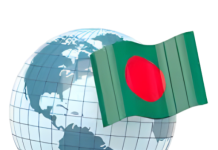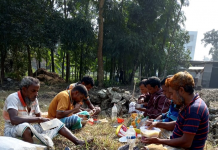The history of Asians living in the Australian continent dates back to thousands of years. Historical research points to the fact that nomadic Asians wandered into the Australian continent as its first inhabitants (now known as the “First Nation”) when it used to be a one-continuous land mass. Asians are indeed the first settlers and rightful owner of this continent.
Yet, the English settlers who sailed to Australia only in 1770 and encountered only a few of its aboriginal inhabitants, declared it a “wasteland” that belonged to no one! In 1835, 47 years after the arrival of the First Fleet of Captain Cook, the Governor of New South Wales (NSW), Richard Bourke, proclaimed the legal principle of Terra Nullius – a Latin expression meaning “nobody’s land” – as the basis for British settlement in Australia.
And what a mockery it was, even legitimized by passing it as a law in the British parliament! Later in 1901, the self-proclaimed English owners of this continent enacted the infamous ‘White Australia policy’, a term encapsulating a set of racial policies that aimed to forbid people of non-European ethnic origins, especially Asians, from immigrating to Australia.
More than half a century later, March 1966 was a watershed moment in the history of Australian immigration. By abolishing the infamous White Australia policy, non-European migrations took on a slow start. Australia’s Bangladeshi families started trickling in from the early 1970s, in contrast to the handful that had arrived in earlier years through marriages, church connections and in other ways.
It is in that era and even earlier, that most of us look for the origins of Bengali migration. However, the find of an age-old Bengali poetry book (পুথি) called, Kasasul Ambia(stories of prophets & saints, published in 1849 from Kolkata) in a discarded mosque in Broken Hill, NSW augmented the perception that Bangalese (Bengalis) stepped into this continent long before it was thought to be. One of our own, Samia Khatun, took up the painstaking task of travelling through and researching the barren deserts of Australia, printing presses and obscure libraries of Kolkata to discover that Bangalese had set foot in this continent way back as far as 1860 or even earlier!

Dr. Khatun’s exploration also unearthed, due to the British colonization of India, people from South Asia and the Indian subcontinent started coming to this continent from the birth of Australia as labourers, housemaids, midwives and other such occupations. It is believed that many of the first to enter the country from the Indian subcontinent were Bengali ship workers.

They were then known as Laskars, most of whom were recruited from the port of Calcutta (Kolkata). The Sydney Gazette and New South Wales Advertiser, dated 23 March 1806 provided the following documented evidence of the Bangalese’ entry and presence in the continent in the 19th century: “On 23rd March 1806, the Laskars of Calcutta organized a spectacular parade on the streets of Sydney on the occasion of Muharram”.
It was on the ships manned by the Laskars that Afghan Camel riders started coming to Australia from 1860. These camel riders were known to the locals as Afghans and soon, that name was conferred upon every person who came from the Indian subcontinent. Some of the Bengalese who landed in this continent somehow or other mainly engaged themselves as hawkers (travelling salesman), and travelled to the remote parts of Australia selling their goods and wares, were also known as Afghans in general.

Afghan cameleers unloading camels at Port Augusta, South Australia
Some researchers indicate that Australia may have, in fact, seen Bangalese prior to the 1800s. While Captain Cook was sailing from England in 1770, some of his English convict crews became seriously ill or died, and he was in desperate need of hands-on deck. While sailing through the Bay of Bengal, after the defeat of Nawab Siraj-ud-doula, he is said to have picked up the defeated and jailed soldiers of Bengal to man his ship. Anyhow, these theories still remain uncorroborated. Some hints had been found in that direction, but requires further investigative research.
On to more recent history, the story of a young Bangladeshi immigrant visiting his hometown of Sylhet in the early 1970s comes to mind. A village elder approached this visitor and asked him if he lived in “Ostalia”. When the young man confirmed this, the elderly gentleman asked him about the “habur bidge”. He, of course, meant the Harbour Bridge.
It turned out that this old man had seen the Harbour Bridge in his younger days on his trips to Australia as a deck hand (Laskar). These crews of merchant ships worked in the lowest of the lower decks and never saw the light of the day until the ships docked in a port. Some took the opportunity to jump ships from time to time. There were a few Bangalese who never returned from those voyages. No one knows what happened to them. If any of them jumped ships at any Australian port, chances are that they remained in Australia and assimilated into the society through marriage, perhaps ‘in the bush’ with the indigenous population.
The first-generation Bangladeshi migrant, as I like to call myself, started slowly trickling in from the early 1970s after the relaxation of white Australia policy. They were mostly trained professionals experienced in computer programming. By the end of the 1970s, there were about 15 Bangladeshi families who lived in close proximity of each other in a suburb called Randwick, a close bus ride away from the Sydney city centre. There were only a very few other Bangladeshis that lived elsewhere.
Halal meat and Indian groceries were rare to find. Things like fresh green chili, karalla, lao and the likes were rare. Women in Sarees or Salwar Kamiz were a rare sight, not to mention of anyone in Hijab. We looked at any coloured or brown skinned man or woman eagerly to find whether he or she spoke Bangla; if not, at least Hindi or Urdu.
There were not so many “Associations” or Porishods during those days as we see now. All forms of socio-cultural activities mostly centred in and around Randwick, organized by one and only Bangladesh Association. The limitation of numbers often resulted in men dressing up as women to perform in dances and dramas. With time, our numbers grew and so did the number of associations/ porishods. We are indeed a very association loving nation, may what our numbers be! I doubt if there are any other immigrant community across the world which has so many associations/groups between them.
The immigrant intake from Bangladesh started to take off in fairly good numbers from the mid-1980s and the number jumped significantly in the 1990s. The latest Census in 2016 recorded 41,237 Bangladesh-born people in Australia, an increase of 48.3 per cent from the 2011 Census. The 2016 distribution by State and Territory showed New South Wales had the largest number with 24,217 followed by Victoria (7,829), Queensland (2,763) and Western Australia (2,578).
Majority (41.6 per cent) of Bangladeshi Australian arrived before 2007; 27.6 per cent arrived between 2007 and 2011 and 28.9 per cent arrived between 2012 and 2016. Understandably, most have settled in urban areas with the highest concentration in Sydney, followed by Melbourne, Brisbane, Adelaide and Perth. However, in recent years a good number of Bangladeshi Australians have also settled in regional towns.
Among the Bangladeshi immigrants, 64.7 per cent were in the age cohort of 25-44 years, according the 2016 Census data. These included professionals in various fields who excelled in their professions on their own rights. We now have highly placed educationists, legalists, engineers, physicians and in every other field of profession in this country. In due course, waves of enterprising Bangalese arrived, who engaged themselves in self-employment or businesses. Today, scores of them are running profitable businesses across the country, employing thousands of their compatriots, who acquire right skills when presented with opportunities.

Among these resourceful Bangalese are importers, retailers, real estate agents, tax and accounting consultants, freelance journalists, publishers of local newspapers, migration agents, interpreters, restaurant owners, specialized men in every aspect of the building industry, solicitors and doctors running independent practices, etc. Some have entered in State and Federal politics, and have earned for themselves a good standing, hitherto unheard of in the first generation of Bangladeshis in Australia.
Meanwhile two of the first-generation Bangladeshis in Australia are proud recipients of the Order of Australia (AOM), an honour that recognizes Australian citizens and other persons for achievement or meritorious services. Another one is a Vice-chancellor of a university and a second-generation migrant who came with his parents as a minor has built himself a top of the ladder software company of this country.
Australia has come a long way from its dark past of racial discriminatory policy against the Asians. This country is now known as a land of opportunity for the deserving and determined ones. It is composed of vibrant multicultural groups of multiple ethnicities, home to the world’s oldest continuous cultures. Since 1945, almost seven million people from every nook and corner of the glove have migrated to Australia. This rich cultural diversity is one of greatest strengths of Australia. It is central to our future generations’ national identity.
Though some of the challenges created in history still remains, we hopefully watch the first generation of Bangladeshi migrants thriving and being successful in their professional and personal lives. We sit back and see our children and grandchildren navigate the challenges of life, education, work and community while they function as an integral part of Australia. This is no small achievement considering that our generation had to make a fresh start in life in a distant and unfamiliar land. I believe it is an onus on us to record our past struggles in our new country and our contributions to and for our adopted home. Unless we do that now, most of our stories are likely to go into oblivion. We owe it to our coming generations to let them know how and where they came from. We owe them an understanding of why we decided to leave the land of their forefathers in search for something new. The story must be told.

Mostafa Abdullah migrated to Australia in the 1970s. He is one of first-generation IT professionals of Bangladesh and retired as the Chief of Party (COP) of USAID Project for establishment of Bangladesh Energy Regulatory Commission. He remains active within the diaspora community in his retirement, collecting stories of the early settlers and their children growing up in the cross-roads of Bangladeshi and Australian culture.



